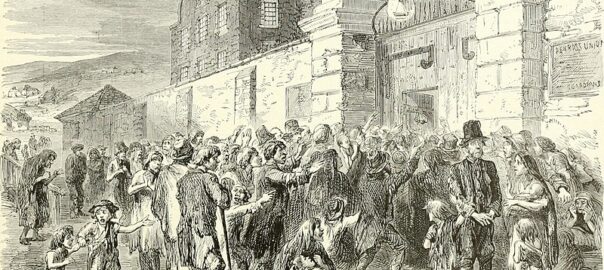The Irish Potato Famine was the most catastrophic event in Ireland’s turbulent history. It is also regarded as being one of the worst famines in history (in terms of deaths as a proportion of the overall population).
The famine is often referred to as The Great Hunger, a period of mass death from starvation and disease between 1845 and 1852. This temporary exhibition tells the story of what happened and why.
After centuries of British colonial rule, a large section of the Irish population lived in extreme poverty and depended on the potato as their main (and often their only) food source for survival.
Centuries of British invasions, land confiscations and anti-catholic laws had reduced the country and its people to levels of poverty not seen in other parts of Europe.
At the same time, Britain was booming and in the throes of the industrial revolution. Ireland was part of the United Kingdom at this time and might have expected to benefit accordingly. But this was not to be.
Massive and speedy humanitarian aid was required when the potato crop failed. Instead the British Government acted slowly and in a fragmented way. Their overriding concern was not to disrupt market forces, so food continued to be exported to Britain as the Irish starved.
The Great Hunger devastated Ireland. At least a million died, perhaps even 1.5 million – we will never know the true figure. Millions more were forced to flee the country. The population of the island has never recovered.
From a population of between 8 and 9 million in 1845, a steady decline ensued for the next 150 years while other European populations grew.
This exhibition tells the story of what happened during those horrific years. The exhibition uses rare 19th century photographs, witness accounts, and contemporary sketches, as well as maps and statistical information. A 15-minute film explains the background to the Famine.
The exhibition contains a number of museum artefacts such as a Famine Pot from County Donegal, a workhouse coffin carrier and a letter from a father to his son who fled the Famine. The famine pot which was used to make soup is perhaps the ultimate famine memorial. The pots were mainly manufactured in Coalbrookdale in Shropshire, England, by a Quaker iron foundry run by the Darby family. The pots were made of cast iron. 600 pots were supplied by the Government, a further 295 were provided by the Quakers themselves, and some also came from the United States. In the summer months of 1847, approximately 3 million Irish People relied on soup from these pots for their survival.
Opening Hours:
April to Sept: 7 days a week 12pm – 6pm, last entry 5.15pm.
Closed Oct to May.
Contact & Pricing:
theirishpotatofamine.com
[email protected]
Second Floor, St Stephens Green Shopping Centre, Dublin 2.
Adults €14; concessions
